Mythic Birds With Crests on Head in World Art
Flights of Imagination: How Birds Accept Been Reinvented As Mythical Creatures Around The Globe
Share: ︎ ︎
Mythical creatures can exist constitute in nearly any civilisation around the world, and they can have on a diverseness of forms. Often, they likewise brand reference to indigenous species of flora and fauna. When we recall of mythical beings that bear resemblance to real life creatures, information technology becomes clear that some have emerged as prototypes for these processes. In particular, birds have been invented, reinvented, collaged, embellished and redefined beyond space and time.
Owing to the fact that birds tin can be found beyond all vii continents, they have featured as characters in fictional stories (Jemima Puddle-Duck or Kehaar in Watership Down), cartoons (Big Bird in Sesame Street or Bad Badtz-Maru past Sanrio) and movies (Iago in the animated Aladdin films). They also characteristic prominently in mythologies. These bird-like creatures ofttimes draw upon characteristics associated with birds, such as feathers, wings, beaks or talons. Within stories about these creatures, their characteristics or abilities are often highlighted or made obvious. Sculptures, drawings and paintings could be fabricated in these creatures' likenesses besides. These could have been used to illustrate stories, or equally tools to further dramatise their telling. Through iconographies and representations, artists imbued mythical beings with physical shapes or forms, evidencing an indelible relationship between word and image.
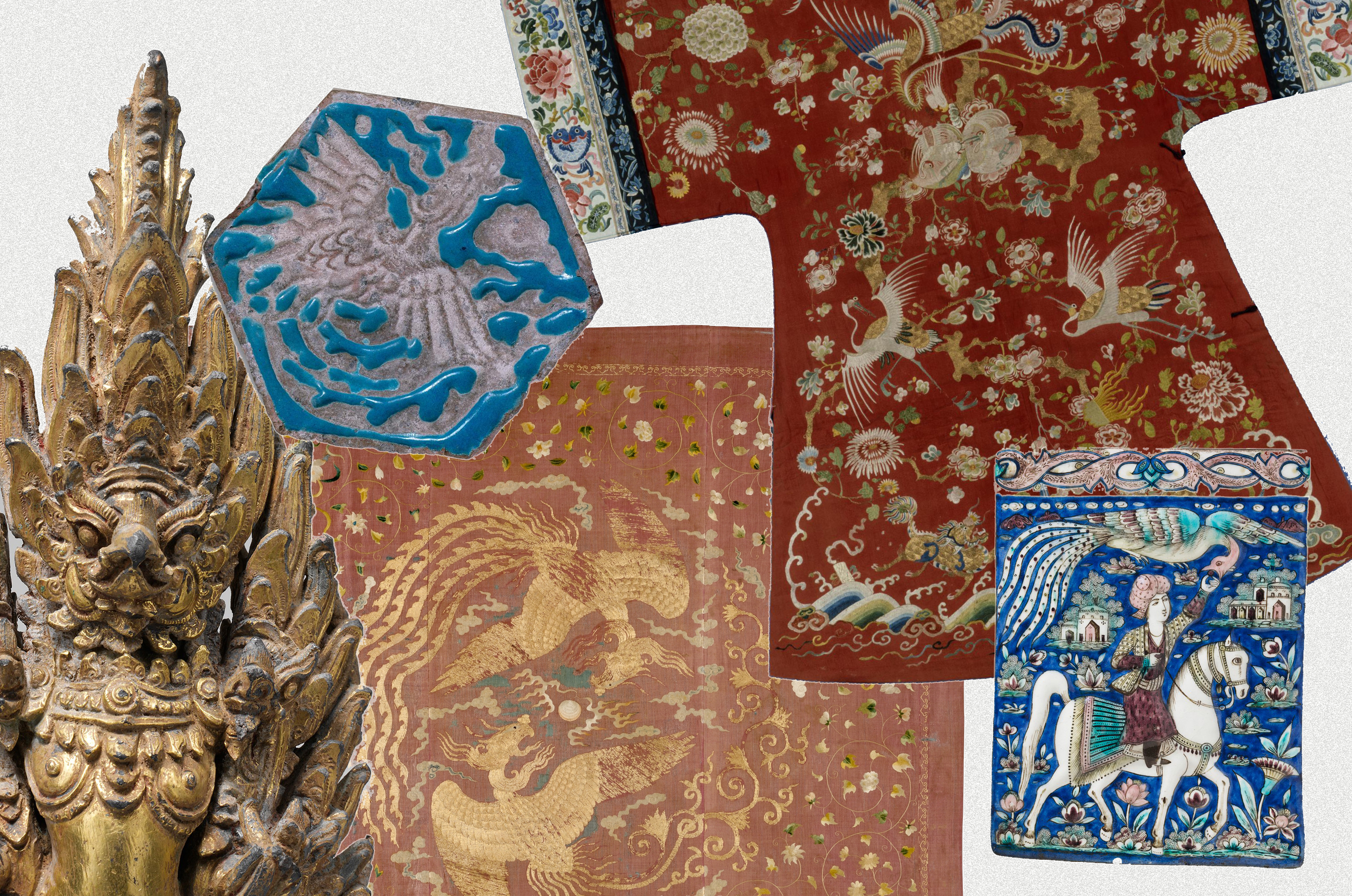
SIMURGH
In Iranian literature, the simurgh (سیمرغ) is a mythical bird that features within poetry.1 Most notably, information technology features within the Shahnameh (Book of Kings) as the protector and guardian of Zal, a dandy warrior-male monarch. Zal was born with white hair, and was abased in the Alborz Mountain every bit a infant because of this. The simurgh found the child, and took him in as her ain. She cared for the young king until he defenseless the eye of a passing caravan. Before parting, the simurgh handed Zal three feathers from her tail, and promised to come to his rescue whenever he lit any of them. This story has been illustrated in many Shahnameh manuscripts, with the most prominent being the painting of the scene in the Shahnameh of Shah Tahmasp.
The simurgh also features in other important works of Persian literature. Written by Farid ud-Din Attar in the 12th century, The Conference of the Birds, is centered around a quest for the legendary Simurgh. Inside Sufi mysticism, the simurgh is oft used equally a metaphor for God. Equally such, the quest outlined in The Conference of the Birds was really a search for divine presence and wisdom.two
¹Zal is Sighted by a Caravan, attributed to Abdul Aziz
Freer Sackler Gallery, c. 1525
²The Simurgh Returning Zal To His Begetter, Page From A Shahnama Of Firdausi
Seattle Fine art Museum, c. 15th-16th century
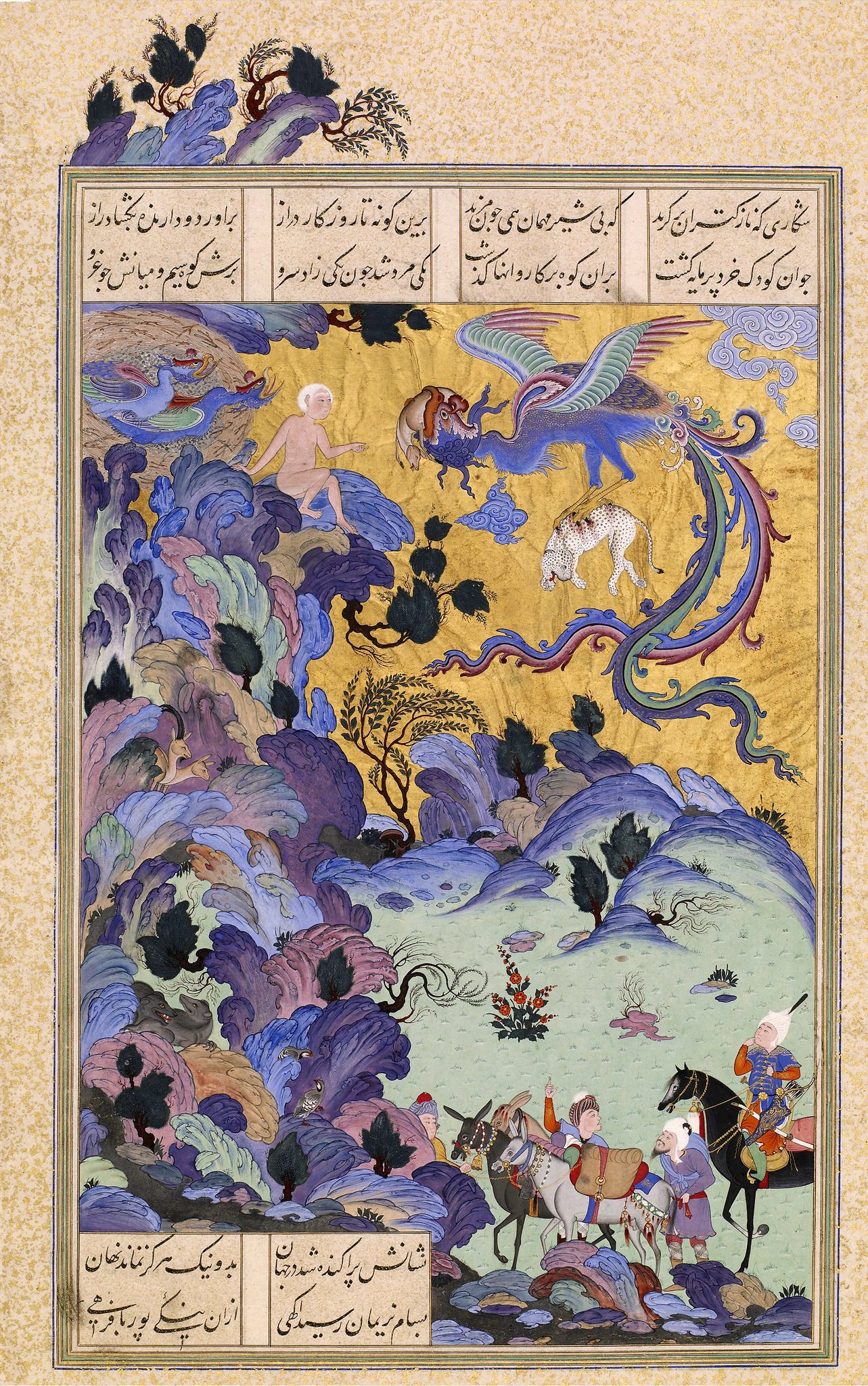

The simurgh is commonly depicted as a large, brightly coloured bird with magnificent tail feathers. The origins of the simurgh could accept been in Zoroastrian religious texts. Mention is made in the Zoroastrian holy volume, the Avesta, of a mythical bird called the senmurv.3
Depictions of the Persian simurgh are like, in many ways, to the East Asian phoenix, or fenghuang. Both mythical birds are oft portrayed with impressive feather and their wings spread wide, mid-flight.
³Tile with a Simurgh (Sechseckfliese mit Simurgh)
Museum für Islamische Kunst, Staatliche Museen zu Berlin, c. 1270
⁴Tile with Horseman Feeding Simurgh
Harvard Fine art Museums, c. 1860
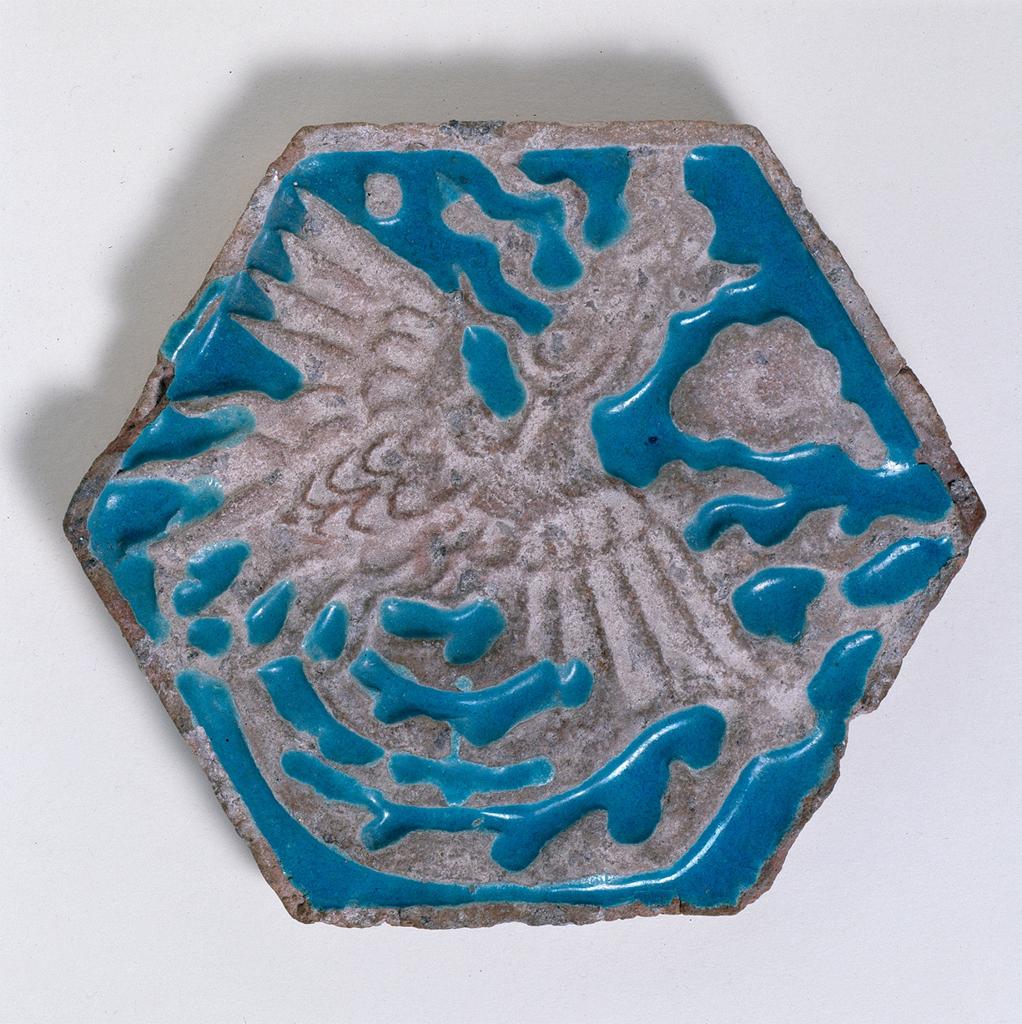
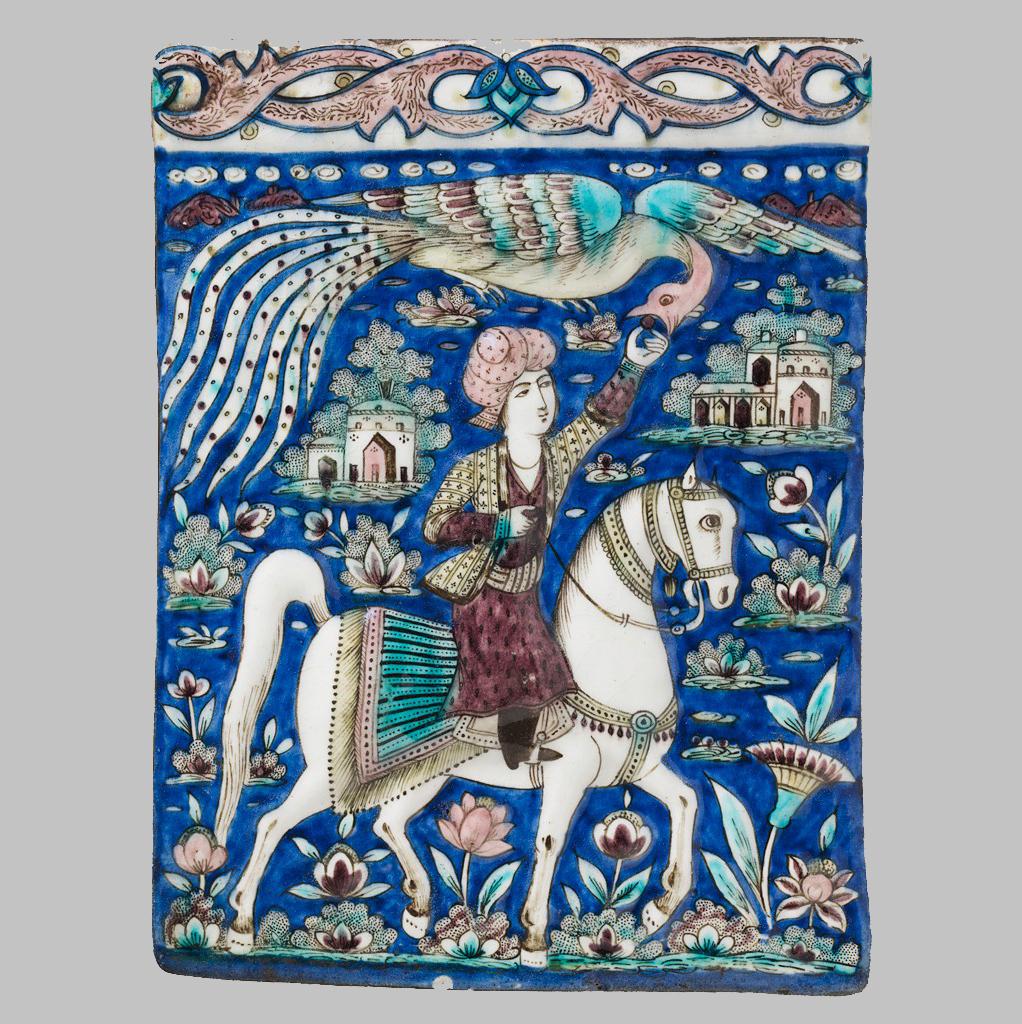
FENGHUANG
The East Asian phoenix, or Fenghuang (凤凰), is an auspicious symbol associated with virtues of benevolence, righteousness, propriety, wisdom, and sincerity.four Phoenixes were also ofttimes paired with some other mythical creature, the dragon. The Outset Emperor of China, Qin Shi Huang, proclaimed himself having descended from the dragon. This meant that the Empress was often associated with images of the phoenix, and phoenixes would often appear alongside dragons on royal insignia. A phoenix sighting also bode well for the purple court, equally it was thought to symbolise a period of peace and security for the empire. The symbolism of the phoenix has shifted over time, simply information technology has always been associated with cheering occasions and virtuous activity.
Phoenixes can exist establish on textiles, jars, bowls, plates, paintings and jewelry. A couple of visual markers have been used to set phoenixes autonomously from other birds, mythical or not. Co-ordinate to the Erya (尔雅), the oldest surviving Chinese encyclopaedic volume, the phoenix has a cock'southward caput, a ophidian's cervix, a eat's chin, a tortoise's back, and a fish's tail. These attributes tend to be stylised in visual portrayals, with its avian features, such as feathers and talons, emphasised. Within Chinese literary tradition, the phoenix was also said to balance only on branches of the paulownia tree. This meant that in visual depictions, the mythical bird would oftentimes be accompanied by lush foliage.
⁵Console with Phoenixes and Flowers
The Metropolitan Museum of Art, c. 14th century
⁶Robe
Victoria & Albert Museum, c. late 17th century - 18th century

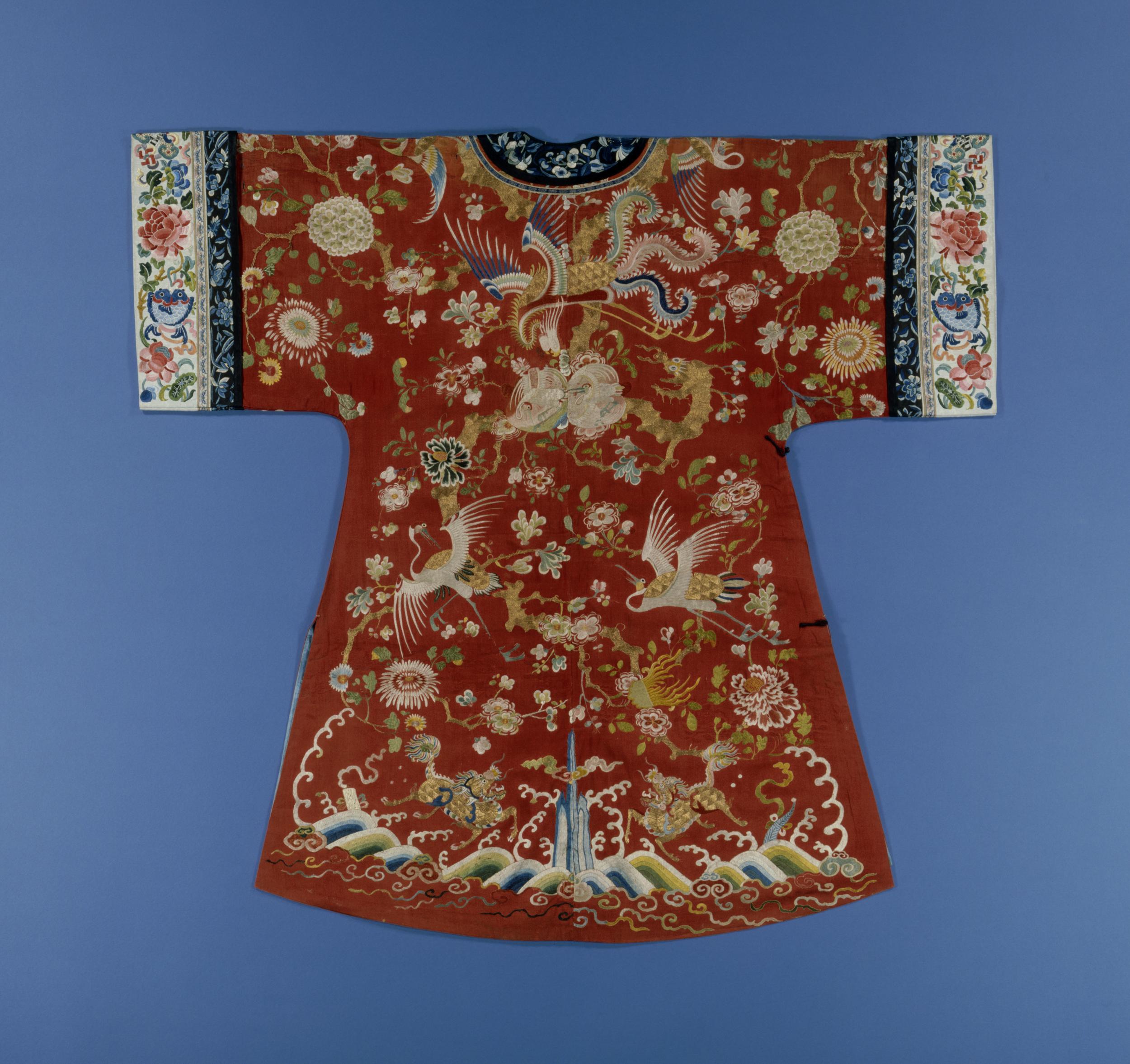
It was too bespeak of reference for many post-Mongol Persian visual representations of the simurgh. With the Mongol conquest of Communist china and much of Central Asia, well established travel routes between the ii regions were reinvigorated, facilitating trade and cross-cultural exchanges. Looking at depictions of the simurgh and the fenghuang, many scholars accept noted the articulate resemblance betwixt the two.
⁷Phoenix, Xu Bing
MASS MoCA, 2008 - 2010/2012
GARUDA
The garuda is a mythical bird or bird-similar beast that can be found within Hindu, Buddhist and Jain traditions. Although these three religions emerged in India, they took root in other places such as Maritime Southeast Asia, Nepal and Tibet. As such the manifestations of symbols such as the garuda are varied across places, and information technology has been localised to the various cultures within which these religions or philosophies were practiced.
⁸Finial with Garuda and Naga
Honolulu Museum of Art, c. 12th century
⁹Tantric Painting of Garuda
Philadelphia Museum of Art, c. 19th century


Within Hinduism, the garuda is the mount (vahana) of the god, Vishnu.7 The hawkeye-like creature is divine, and has been carved into temple gateways and pillars. In The Mahabharata, the garuda emerges equally immortal and Vishnu's mountain after completing an amazing quest.
In comparison, garudas within Buddhist tradition are a species of mythical beings. They are often seen in opposition to nagas, which are serpentine mythical beings that feature in The Mahabharata as well. Garudas are seen as having a protective function, and they were charged with the protection of Mount Meru.8
¹⁰Krishna on Garuda
The Metropolitan Museum of Art, c. 2d one-half of the 9th century
¹¹Garuda Finial
The Metropolitan Museum of Art, c. late 12th – early 13th century


Cult images are often made of those who have attained moksha in Jainism. A pair of guardian deities, the yaksha and yakshini, volition back-trail the figure. Within this tradition, the garuda is the yaksha of the sixteenth Jain Tirthankar Shree Shantinatha.
Depictions of the garuda oscillate betwixt the zoomorphic and the anthropomorphic. Today, the epitome of the garuda can be constitute on national emblems of countries such as Indonesia, Thailand and Cambodia.
HUĪTZILŌPŌCHTLI
Huītzilōpōchtli (pronounced weetz-ee-loh-posht-lee) is the Aztec deity of war, military conquest, sunday, and cede.nine The deity'due south proper noun translates into "Southern hummingbird" or "left-handed hummingbird".
In that location are differing versions of his origin story, simply the most well known retellings feature cosmological themes of creation. Huītzilōpōchtli was built-in to Coatlicue, the goddess of Venus. Huītzilōpōchtli's siblings, Coyolxauhqui and Centzon Huitznahua, were the goddess of the stars and gods of the stars respectively. The story goes that Huītzilōpōchtli's siblings plotted to kill Coatlicue when they discovered that she was with kid. Equally the siblings attempted to decapitate their mother, Huītzilōpōchtli emerged from her womb and dismembered Coyolxauhqui. All of this relates to his continuing as i of the about important gods within the Aztec pantheon. A capstone excavated from the site of the Templo Mayor depicts Coyolxauhqui dismembered.
¹²Great Coyolxauhqui Stone
Museo del Templo Mayor, c. 1473

One can often identify Aztec deities in art through observing their dress, facial markings or accessories.10 Huītzilōpōchtli has been portrayed either as a hummingbird or an anthropomorphic figure wearing a hummingbird behind his head, or headgear in the likeness of a hummingbird. As the god of warfare, he is often depicted in full armour and holding a scepter in the shape of a serpent.11 In the centre of Tenochtitlan, a big city in the Mexicas, a large temple was dedicated to both Huītzilōpōchtli and Tlaloc (the Aztec god of rain and fertility). This temple, the Templo Mayor of Tenochtitlan, represented the entirety of Aztec worldview.12
"Together Tlaloc and Huitzilopochtli encompass the natural and social universe of the Aztec empire. While Tlaloc was a god of earth and rain, Huitzilopochtli stood for the sun and the sky. Tlaloc marked the time of rains; Huitzilopochtli scorched the earth, with sun and war, in the dry months."
¹³ Huītzilōpōchtli in Codex Telleriano-Remensis
Bibliothèque nationale de France, c. 16th-century
¹⁴ Huītzilōpōchtli in human being form in Codex Telleriano-Remensis
Bibliothèque nationale de French republic, c. 16th-century


Translating oral or textual descriptions into visual formats necessitates processes that are complicated and dynamic. With regions and cultures that were connected by overland and maritime trade routes, it is clear that these interactions immune for pictorial motifs, religious tradition, and even mythical creatures themselves to be shared, exchanged and referenced. This, coupled with rich local traditions, gave ascension to depictions of mythical bird-similar beings that were unique yet intertwined.
Stories course the very basis of many cultures. Although nosotros've come up a long way from gathering around a storyteller, we still are enthralled by modern twenty-four hours tales, both real and imagined. The philosopher David Hume attributed this to causal relations, as nosotros consider ideas of crusade and event. Albeit simplistic in his essentialisation, information technology is interesting that questions virtually the existence of universalising myths continued to perplex Enlightenment scholars. Myths have e'er been a way of explaining and understanding the natural and inhabited world, and considering of this, they will always captivate our imagination.
FOOTNOTES:
¹ Schmidt, Hanns-Peter. "SIMORḠ." Encyclopaedia Iranica. Accessed 14 January, 2019. http://world wide web.iranicaonline.org/articles/simorg.
² Reinert, B. "AṬṬĀR, FARĪD-AL-DĪN." Encyclopaedia Iranica. Accessed 16 January, 2019. http://world wide web.iranicaonline.org/articles/attar-farid-al-din-poet.
³ The David Drove. "Symbolism in Islamic Fine art." Accessed 16 January, 2019. https://www.davidmus.dk/en/collections/islamic/cultural-history-themes/symbolism/art/32b-1987.
⁴ National Palace Museum, Taiwan. "The Dragon and The Phoenix in Chinese Art." Accessed sixteen January, 2019. http://world wide web.npm.gov.tw/exhbition/dro0001/english/c1main.htm.
⁵ Carboni, Stefano and Qamar Adamjee. "A New Visual Language Transmitted Across Asia." Heilbrunn Timeline of Fine art History. Accessed 16 January, 2019. https://www.metmuseum.org/toah/hd/khan4/hd_khan4.htm.
⁶ Wardwell, Anne East. "Flight of the Phoenix: Crosscurrents in Tardily Thirteenth- to Fourteenth-Century Silk Patterns and Motifs." The Bulletin of the Cleveland Museum of Art 74, no. 1 (1987): two-35.
⁷ Dehejia, Vidya. "Recognizing the Gods." Heilbrunn Timeline of Fine art History. Accessed 16 January, 2019. https://www.metmuseum.org/toah/hard disk/gods/hd_gods.htm.
⁸ O'Brien, Barbara. "Garuda: Divine Bird Creatures of Myth." Thought Co. Accessed sixteen Jan, 2019. https://www.thoughtco.com/garuda-449818.
⁹ Maestri, Nicoletta. "Huitzilopochtli: The Aztec God of the Sun, War, and Sacrifice." Thought Co. Accessed 14 Jan, 2019. https://world wide web.thoughtco.com/huitzilopochtli-aztec-god-of-the-sun-171229.
¹⁰ Guggenheim. "Gods & Rituals." Accessed 14 January, 2019. https://www.guggenheim.org/arts-curriculum/topic/gods-and-rituals.
¹¹ Boone, Elizabeth H. "Incarnations of the Aztec Supernatural: The Image of Huitzilopochtli in Mexico and Europe." Transactions of the American Philosophical Club 79, no. 2 (1989): 5.
¹² Guggenheim. "Mexico-Tenochtitlan, Axis Mundi of the Universe." Accessed 15 January, 2019. https://world wide web.guggenheim.org/arts-curriculum/topic/united mexican states-tenochtitlan.
Farther READING:
¹ Whilst preparing for this mail service, nosotros came across a blog that discusses the influence of birds on culture. It goes into further detail as to just how potent and established the connectedness between man society, homo imagination and avian critters is.
alexanderaddapprilk.blogspot.com
Source: https://objectlessons.space/Flights-of-Imagination-How-Birds-Have-Been-Reinvented-As-Mythical

0 Response to "Mythic Birds With Crests on Head in World Art"
Post a Comment